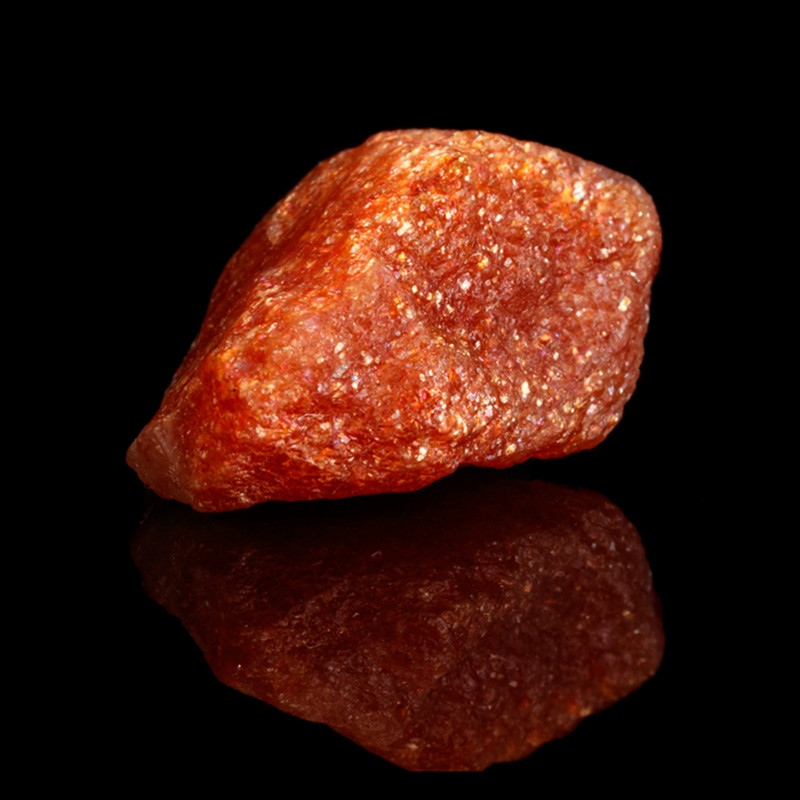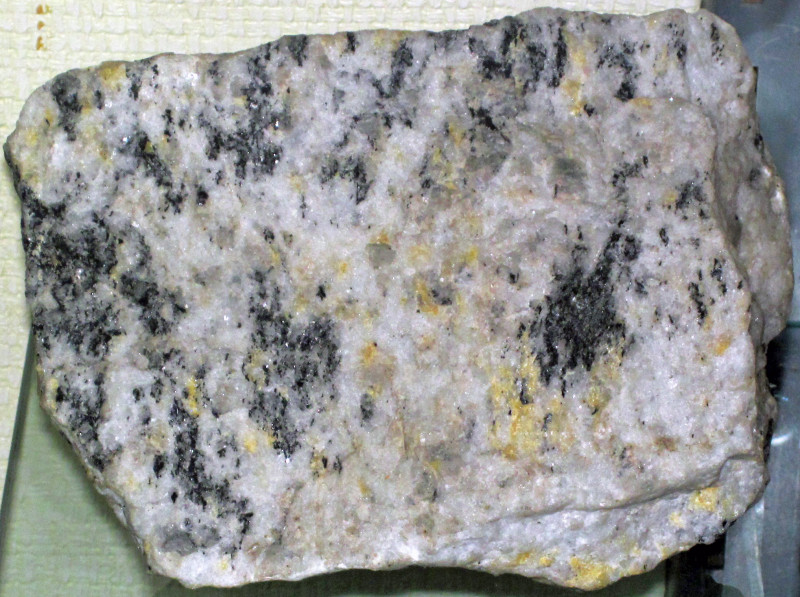Nepheline Gemstone: Properties, Meanings, Value & More
 Nepheline (neff-uh-leen) is a glassy, feldspar-like mineral becoming increasingly important in various industries. The stone is better-known for making up a significant part of nepheline syenite rocks, inside which many other gemstones are found.
Nepheline (neff-uh-leen) is a glassy, feldspar-like mineral becoming increasingly important in various industries. The stone is better-known for making up a significant part of nepheline syenite rocks, inside which many other gemstones are found.
Is nepheline a gemstone? Yes, though cut nepheline gemstones are scarce because the stone rarely forms facetable, gem-quality crystals.
Along with gems like ammolite and sodalite, the best source for high-quality nepheline is the Great White North: Canada!
Intrigued? Come along as we uncover nepheline’s history, properties, healing powers, and more!

About Nepheline Stone
Nepheline, or nephelite, is an important mineral sometimes used as a semi-precious gemstone. It’s usually white, yellow, or gray. Besides nephelite, more synonyms for nepheline include:
Gieseckit
Sommite
Oelstein
Carolinite
Cavolinite
Beaudantine
Fatstone
Oilstone
While not a zodiac stone or birthstone, nepheline is an alternative star stone for the moon and Venus.
Nepheline Uses
Industrial nepheline uses are more widespread than gemstone uses. Fortunately, many of these applications help fight climate change!
So, what is nepheline used for? The most prominent use of nepheline or nepheline-syenite rocks is as a flux material. Nepheline’s alkalis lower the mixture’s melting point so less energy and time is needed, lowering toxic emissions.
This beneficial property makes nepheline beneficial for creating ceramics like tiles, sinks, toilet bowls, countertops, and more.
In a similar vein, nepheline is commonly used as a material in construction (e.g. tiles, railroad tracks, cobblestone pavement). Why? The mineral is durable and highly resistant to weathering or corrosion.
Likewise, nepheline helps make glass stronger and harder by introducing alumina to the mix. Nepheline is becoming a more common substitute for feldspar in ceramics and glass.
One more eco-conscious use for nepheline is in paints. Not only does paint with nepheline retain its hue and brightness against weathering, it doesn’t need more risky (and environmentally unfriendly) volatile organic compounds.
 Image credit: John Sobolewski | Creative Commons Attribution 3.0 Unported license
Image credit: John Sobolewski | Creative Commons Attribution 3.0 Unported license
Nepheline Specifications & Characteristics
Nepheline is a feldspathoid mineral like afghanite, petalite, or sodalite. Feldspathoids are feldspar-like tectosilicates but with less silica and different crystal structure. Though most are rare, nepheline is the most common.
What is the chemical formula of nepheline? The formula (Na,K)AlSiO4 was the accepted version, but 2018 updates from the International Mineralogical Association stated potassium (K) is essential to the mineral. The updated formula is Na3K(Al4Si4O16).
The ideal ratio of sodium to potassium is 3:1 in nepheline’s structure of interlocked aluminosilicate rings. Nepheline may have 3-12 percent potassium oxide, though 8 percent is best.
Usually, nepheline forms compact, granular masses. Crystals are rarer and range from short and stubby to large, both prismatic.
Lastly, nepheline optical properties are unique for displaying satellite reflections. These are areas where diffraction (light bending around an object’s edge) is weak, and they surround brighter reflective areas.
The remaining nepheline mineral properties are below:
Mohs hardness: 5.5-6
Color: Colorless, white, gray, brown, deep red, reddish-brown, yellow, bluish, greenish
Crystal structure: Hexagonal
Luster: Vitreous (glassy) to greasy; Waxy or resinous (eleolite)
Transparency: Transparent to opaque
Refractive index: 1.52-1.54
Density: 2.55-2.66
Cleavage: Indistinct/Poor on [1010]
Fracture: Subconchoidal
Streak: White
Luminescence: Fluorescence in certain locale’s specimens - Light blue (Germany) & orange (Ontario) in LW-UV
Optical effects: Satellite reflections; Sometimes chatoyancy
Types of Nepheline
Nepheline has two varieties: elaeolite and glassy nepheline (or eleolite).
Elaeolite
Elaeolite is a gray, green, brown, or red nepheline variety often found in masses or large crystals. It has a greasy luster and is typically opaque.
The luster and coloring are caused by lots of microscopic spaces filled with inclusions, likely hornblende or augite. The inclusions may create chatoyancy (the “cat’s eye” effect).
Not all mineralogists recognize elaeolite as a distinct variety, but it was largely considered one throughout the 1800s.
Eleolite or Glassy Nepheline
Eleolite, or “glassy nepheline,” is a type of translucent, massive nepheline. It’s often colorless with a red or green tint. The luster can be vitreous, waxy, or resinous. This variety forms small crystals or grains, and the best specimens are found near Vesuvius, Italy.
 Image credit: Nepheline syenite from the Pennsylvanian of Maine, USA. (public display, Geology Department, Wittenberg University, Springfield, Ohio, USA) | Flickr
Image credit: Nepheline syenite from the Pennsylvanian of Maine, USA. (public display, Geology Department, Wittenberg University, Springfield, Ohio, USA) | Flickr
Nepheline Syenite
Nepheline syenite isn’t a mineral but a rock type often discussed alongside nepheline.
These plutonic igneous rocks are completely crystalline (holocrystalline) and pale, usually pink or gray though some are dark green.
The primary minerals in these rocks are nepheline, sodalite, and alkali feldspar, usually orthoclase. Possible secondary minerals found in nepheline syenite include apatite and magnetite.
Nepheline vs. Quartz
Colorless nepheline can resemble quartz, as both share a low refractive index and weak double-refraction.
So, how can you tell quartz from nepheline?
With a microscope, you can check the optic sign — nepheline’s sign is negative while quartz’s sign is positive.
Another distinction is hardness. Quartz ranks at 7 on the Mohs mineral hardness scale, while nepheline ranks at 5.5 to 6. That means materials with 6.5 hardness like a steel file/needle or spodumene will scratch nepheline but not quartz.
Nepheline Meaning & History
Nepheline symbolizes revelation, truth, and self-awareness.
The name “nepheline” derives from the Greek nephele, meaning “cloud.” Though the reason for this is more scientific, this connection could also be interpreted metaphysically. Clouds symbolize mysteries, deities, and dreams, so nepheline can possess these meanings as well.
History
French mineralogist René Just Haüy chose the name “nepheline” for the new Italian mineral in 1801. The “cloud” meaning reflects nepheline’s habit of becoming cloudy or hazy when submerged in acid.
Also in 1801, Danish naturalist Heinrich C.F. Schumacher studied nepheline specimens from Norway and named them “gabbronite,” though gabbronite is now a name for a scapolite variety.
In 1809, German chemist Martin Heinrich Klaproth and mineralogist Dietrich Ludwig Gustav Karsten also analyzed nepheline from Norway. They named the variety “elaeolite” after the Greek word élaion, meaning “oil” after its greasy luster.
Canadian miners discovered nepheline in the Havelock area in the 1890s. Mining started in 1932, when Ontario’s Blue Mountain mines were established. It gradually became a full-on Canadian industry.
Remember those industrial uses we discussed? Canada was the first to use nepheline syenite industrially for ceramics and glass. For a long time, they were the only producer worldwide.
Today, roughly two-thirds of their nepheline syenite production goes toward glass for fiberglass, containers, and panels used for windows or doors.
Now let’s peer behind nepheline’s glossy surface to uncover its metaphysical properties!
 Image credit: Kelly Nash | Creative Commons Attribution 3.0 Unported license
Image credit: Kelly Nash | Creative Commons Attribution 3.0 Unported license
Nepheline Healing Properties
All gemstones can be unique healing stones with properties tied to their vibrations and coloring. The most common nepheline color is white, meaning it’s cleansing and amplifying like other white gemstones.
Yellow and gray are also common undertones. Thus, nepheline serves as a chakra stone for both the grounding root chakra and creativity-boosting sacral chakra.
Some other purported healing properties of nepheline include helping to:
Reduce stress
Promote better sleep and fewer nightmares
Soothe anger
Increase self-esteem and self-awareness
Boost creativity
Release you from a period of melancholy
Next, we’ll discuss some factors to look for when browsing nepheline for sale.
Nepheline Gemstone Properties
Though nepheline gemstones aren’t super common, they’re still graded similarly to most gems, based on color, cut, clarity, and carat weight. Below, we’ll give a brief overview of each of these properties:
Color: Most are colorless or white with a gray or yellow undertone. Gray hues may be due to magnesium impurities. Deeper or more interesting colors like reddish-brown, green, or blue may be more valuable.
Cut: Transparent nepheline may be faceted, though these gems are rare. Chatoyant elaeolite must be cut en cabochon to display its “cat’s eye.”
Clarity: Inclusions in elaeolite are common, sometimes producing chatoyancy. Nepheline may have mirror-like inclusions or semi-healed fractures, but it’s more valuable if it lacks inclusions.
Carat Weight: Faceted gems are only 1-2 carats at most. Nepheline cabochons range in size. Canadian crystals can reach 15 inches (38.1 cm) long.
Scientists have created synthetic nepheline, but it’s not used in jewelry.
One important warning for buyers: There’s been a rise in Ebay sellers marketing aragonite as nepheline. If you see hexagonal crystal clusters from China with orange to brown coloring listed as nepheline, they’re trying to dupe you.
Back to the real deal, how is nepheline formed?
 Image credit: James St. John, Nepheline syenite (Ice River Complex, Early Mississippian; southeastern British Columbia, Canada) | Flickr
Image credit: James St. John, Nepheline syenite (Ice River Complex, Early Mississippian; southeastern British Columbia, Canada) | Flickr
Nepheline Formation & Sources
Nepheline almost always forms inside igneous rocks that were formed from magma low in silica. The most common rocks are nepheline syenites, phonolite, and foidite.
Glassy nephelines can occur as crystals in young lava. Elaeolite is found in older rocks.
The biggest group of nepheline-bearing rocks sits in the Kola Peninsula of Russia. Speaking of, where is nepheline found?
Mining Locations
Nepheline is found worldwide, but most locales don’t produce large quantities. One exception is Ontario, Canada, where huge amounts of near-pure material is mined.
Afghanistan is another world-class nepheline locale. Maine, USA, is significant for glassy nepheline, while Norway is important for elaeolite.
Other notable sources for nepheline include:
China
Finland
France
Germany
Greenland
Italy
Myanmar
North & South Korea
USA (Arkansas, Maine)
Before we wrap up, how much does nepheline cost?
Nepheline Price & Value
Transparent, faceted nepheline with yellow coloring can reach beyond $800 per carat because they’re so rare. However, combinations of nepheline and other minerals, faceted together, are much less costly.
Reddish-brown and white nepheline with water inclusions range from $20-$30 per carat. Gems with biotite inclusions are generally $15-$20 per carat.
Cabochons are generally $2-$5 per carat. Polished nepheline stones mixed with aegirine and eudialyte are pricier, around $150-$200 per carat. Pure nepheline crystals, raw, vary broadly from around $12 to $900.
Lastly, we’ll teach you about gemstone care!
Nepheline Care and Maintenance
Nepheline’s mid-range hardness means you may want protective settings on vulnerable jewelry like nepheline rings. Don’t wear it during impact-prone activities.
Clean nepheline with mild soap, lukewarm water, and a soft toothbrush. Dry it with a soft, dust-free cloth. Store separately from other gems. Keep the stone away from acids.
Nourish Your Spirit with Nepheline!
As an industrial mineral, nepheline has only gotten more popular over time. Though it’s not as popular as a gemstone, this crystal is a spiritual tool for rejuvenation and creativity!
Was this article helpful?
Ross Sedawie
- Written - 23rd Jul 2022
- Edited - 1st Aug 2023
















